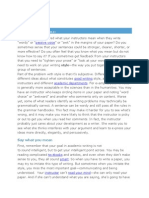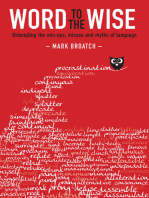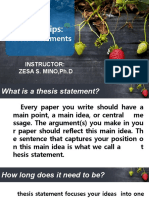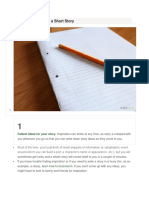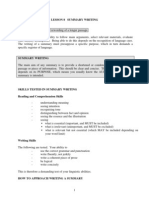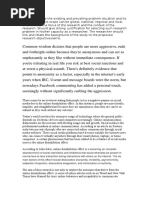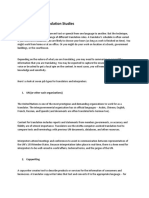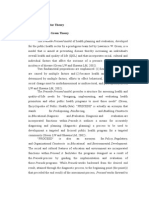0 ratings0% found this document useful (0 votes)
Feature Writing Part 3
Feature Writing Part 3
Uploaded by
Farhad HashemiThis document provides tips and techniques for creative writing devices that can be used to strengthen writing through the revision process. It discusses using the active voice, specific details, imagery, quotes, characterization, showing rather than telling, and vivid scene descriptions. It also provides writing exercises for writers to practice being more specific, finding descriptive words, and writing character descriptions.
Copyright:
© All Rights Reserved
Available Formats
Download as PDF, TXT or read online from Scribd
Download as pdf or txt
Feature Writing Part 3
Feature Writing Part 3
Uploaded by
Farhad Hashemi0 ratings0% found this document useful (0 votes)
This document provides tips and techniques for creative writing devices that can be used to strengthen writing through the revision process. It discusses using the active voice, specific details, imagery, quotes, characterization, showing rather than telling, and vivid scene descriptions. It also provides writing exercises for writers to practice being more specific, finding descriptive words, and writing character descriptions.
Original Description:
Part 3 of Feature Writing
Copyright
© © All Rights Reserved
Available Formats
PDF, TXT or read online from Scribd
Share this document
Did you find this document useful?
Is this content inappropriate?
This document provides tips and techniques for creative writing devices that can be used to strengthen writing through the revision process. It discusses using the active voice, specific details, imagery, quotes, characterization, showing rather than telling, and vivid scene descriptions. It also provides writing exercises for writers to practice being more specific, finding descriptive words, and writing character descriptions.
Copyright:
© All Rights Reserved
Available Formats
Download as PDF, TXT or read online from Scribd
Download as pdf or txt
0 ratings0% found this document useful (0 votes)
Feature Writing Part 3
Feature Writing Part 3
Uploaded by
Farhad HashemiThis document provides tips and techniques for creative writing devices that can be used to strengthen writing through the revision process. It discusses using the active voice, specific details, imagery, quotes, characterization, showing rather than telling, and vivid scene descriptions. It also provides writing exercises for writers to practice being more specific, finding descriptive words, and writing character descriptions.
Copyright:
© All Rights Reserved
Available Formats
Download as PDF, TXT or read online from Scribd
Download as pdf or txt
You are on page 1/ 22
Feature Writing Part 3:
Creative Writing Devices
MEDIA WRITING LECTURE 7
Housekeeping
Assignment #1 is due next Friday, 12PM
Remember: Softcopy (via TIMeS) & Hardcopy (assignment,
turnitin report, assignment cover sheet and assignment
feedback form/marking scheme).
Where to hand in hardcopy? Box outside Block C Level 9 (Turn
right at main glass door, walk towards toilets, at the end of
the passageway, there is another glass door. There will be a
box on the left corner by that glass door.)
No LECTURE OR TUTORIAL next week. LECTURE SLOT
= consultation hours (10-11.30AM LT22, I will be there).
No need consultation? Spend your free week wisely and
complete the assignment well.
Good writing requires good editing
REVISING YOUR COPY
One of the hardest lessons to learn is how to revise
ones copy.
Most writers, no matter how experienced they are,
find it difficult to put words to paper with exactly
the right order, tone and quality on the first try.
Therefore, they continue to polish and refine what
they have written.
The refining process doesnt come easily.
Too many writers fall in love with their own language.
Once they commit it to paper, they cant bring
themselves to throw away this beautifully turned
phrase or that five-syllable word, or those scintillating,
unnecessary adjectives, no matter how inappropriate
the wording might be to the end product.
As writers, you must train yourself to treat words as
tools, not as tiny mirrors to your own brilliance and
wit.
You must force yourself to stand back from your own
copy and study it on its own merits.
In effect, each writer is his or her own worst enemy.
As any good professional can tell you, youll only begin
to improve as a writer only when you learn to spot
your mistakes and weed them out.
Tips to better writing
Time creates distance.
It allows personal enthusiasm to wane and
sharpens judgement.
If you arent pressed for time, take advantage of it.
Give yourself a mandatory cooling-off period.
Stack your copy and lay it aside for a few days.
When you come back to it, divorce your ego from
it.
Try and read it as though it came from someone
elses computer.
What can you do?
1. Examine your copy from several perspectives as
editor, reader and critique.
2. Check the structure to see if it works.
3. Test each paragraph for flow and linkage to its
neighbours.
4. Study each sentence for weaknesses and make
sure you dont have any spelling or punctuation
problems.
Remember that editing for the sake of editing
accomplishes nothing each correction must improve
the copy.
USEFUL WRITING DEVICES
Some standard writing devices that can strengthen
your material in the process of revision.
Use the active voice
Its better to make the subject of your sentence do
something rather than let something be done to it.
The man stabbed the child is stronger than
The child was stabbed by the man.
The first sentence is active and the second, passive.
But theres more to putting action in your verbs
than merely avoiding the passive voice.
Be specific
Whenever possible, skip generalisation and be
concrete.
Tom Williams fell down is not as effective as
Tom Williams tripped on slab of concrete before losing
his balance and falling into the gutter
Continued
Never settle for the first verb that pops into your
head, if theres a better one available.
Look for verbs that are closer to your meaning.
Dont use shout if what you really mean is bawl or
bellow or roar or shriek.
Check your thesaurus for synonyms.
Thumb your dictionary and thesaurus for words
with precise meaning.
Use imagery
Remember that verbs can be abstract too.
The wind blew through the trees tells the reader
something but not enough.
Was it a soft breeze? Try imagery. The wind
whispered through the trees.
Perhaps it was a heavy wind The wind trashed the
trees.
Either verb gives the reader a better clue than the
first to the strength of the wind.
But if you use imagery, be selective.
Imagery should be used to illuminate, not to show
off.
Brighten your articles with quotes
Your readers like to hear people talk.
If you are writing a profile about a specific person,
by all means let the reader listen in on what the
profile subject has to say.
Quotes enliven your copy even if you arent writing
a profile.
Use quotes freely but, again, be selective.
Your story should not be all about quotes; quotes
enhance not monopolise the story.
Use characterisation
Not only do your readers want to hear a person talk,
they want to see the person.
Bring the people in your article to life. Allow
your readers to picture them vividly.
Give them a glimpse like the following excerpt:
Ken Johnson is a short, rumpled little man who wears a
green beret and his collar turned up. He has a fat nose and
big ears and he looks a bit like one of the gargoyles on the
Cathedral Notre Dame.
Continued
A writer can also give readers insight into a persons
character by:
showing the person in action
demonstrating the persons attitudes and personality
presenting significant biographical details
showing the reactions and comments of other people
If you intend to delve into a subjects character, you
should get to know the subject well.
Be observant when you go in for an interview.
Watch for mannerisms.
Make notes of things that impress you visually, as
well as taking down the subjects words
Show, dont tell
Dont be judgmental. If you tell a reader that a
person is friendly, or nervous, or angry, or
despondent, the reader may get some idea what you
mean, but judgmental words represent different
things to different people.
Show the reader. Show:
The shy smile
The shaking hands
The gritted teeth
The long, low sigh
Instead of writing The professor acted strange, say
The professor drooled on his tie, staggered against the
blackboard and slid to the floor moaning
Describe scenes
Vivid, brief descriptions of scene and setting can help
immensely in holding readers attention and propelling them
through a story.
Description can create atmosphere or mood without telling a
story.
The jukebox is almost hidden under the stuffed head of a
buffalo. Someone has dropped in a quarter and punched that
old western favourite, Laras Theme, by Roger Williams.
Diners are sipping screwdrivers and martinis and whittling
on two pound T-Bones. Every so often there is a choink as
somebody pops a beer top.
Writing Exercises
Be Specific: Write the following in more specific
sentences
Alison injured her knee after falling.
Ken is sad after failing.
Melanie raised her voice to her sister, Candice, during a fight.
George was frightened by the sound.
Luke was happy after winning the competition.
Find more descriptive words for the following: at least 2
different words for each
Anger
Sad
Confusion
Upset
Content
Confused
Tired
Run
Eat
Happy
Write a 1 paragraph description of the following person
to make her look attractive.
40-year-old Sandy Atkins
Short
Average weight, small waist, wide hips
Doesnt smile a lot
Wears boring clothes
Wears glasses
Chin length brown hair with a blunt fringe
Blue eyes
Has a hairy mole on right cheek
Large nose with wide nostrils
You might also like
- A1.1 An Introduction To The Spanish Language86% (7)A1.1 An Introduction To The Spanish Language8 pages
- Clickass Copywriting: 125 Quick Tips to Sharpen Your Copywriting SkillsFrom EverandClickass Copywriting: 125 Quick Tips to Sharpen Your Copywriting Skills5/5 (10)
- What The Dime Is in A Name - Mwadimeh Wa'kesho100% (1)What The Dime Is in A Name - Mwadimeh Wa'kesho3 pages
- How To Edit Your Own Writing by Harry GuinnessNo ratings yetHow To Edit Your Own Writing by Harry Guinness5 pages
- Be a Successful Writer in a Nutshell - 100+ Writing Tips: Be a WriterFrom EverandBe a Successful Writer in a Nutshell - 100+ Writing Tips: Be a WriterNo ratings yet
- Word to the Wise: Untangling the Mix-ups, Misuse and Myths of LanguageFrom EverandWord to the Wise: Untangling the Mix-ups, Misuse and Myths of LanguageNo ratings yet
- David Ogilvy’s Famous “10 Tips on Writing” Memo Plus BONUS Color, Context, And nNo ratings yetDavid Ogilvy’s Famous “10 Tips on Writing” Memo Plus BONUS Color, Context, And n8 pages
- Thinking Well and Writing Well NDSU 10-15-2013 PDFNo ratings yetThinking Well and Writing Well NDSU 10-15-2013 PDF29 pages
- Lesson 5 Thesis Statement of An Academic Text: Prepared By: Ms. Andrealene L. GuilledoNo ratings yetLesson 5 Thesis Statement of An Academic Text: Prepared By: Ms. Andrealene L. Guilledo16 pages
- How To Create An Instant Bestselling NovelNo ratings yetHow To Create An Instant Bestselling Novel7 pages
- A Brief Guide To Writing Descriptive EssaysNo ratings yetA Brief Guide To Writing Descriptive Essays6 pages
- Most Essential Learning Competency: States Thesis Statement of An Academic Text100% (1)Most Essential Learning Competency: States Thesis Statement of An Academic Text4 pages
- Creative Writing Activities For Short Stories100% (1)Creative Writing Activities For Short Stories4 pages
- Clear and Effective Writing The News StoryNo ratings yetClear and Effective Writing The News Story37 pages
- Should Describe The Existing and Prevailing Problem Situation and Its SignificanceNo ratings yetShould Describe The Existing and Prevailing Problem Situation and Its Significance2 pages
- Bhasa & Kalidasa 2 Centruy India Vedas SanskritNo ratings yetBhasa & Kalidasa 2 Centruy India Vedas Sanskrit1 page
- Aspects of The Theory of Syntax Noam Chomsky 1965No ratings yetAspects of The Theory of Syntax Noam Chomsky 1965292 pages
- Pearson Edexcel: International GCSE and GCE A Level Price List November 2021 BangladeshNo ratings yetPearson Edexcel: International GCSE and GCE A Level Price List November 2021 Bangladesh12 pages
- Focus3 2E LessonPlans U01 Lesson6 7 GrammarNo ratings yetFocus3 2E LessonPlans U01 Lesson6 7 Grammar2 pages
- AutomationNetworkSelection 3rded Chapter3 PDFNo ratings yetAutomationNetworkSelection 3rded Chapter3 PDF31 pages
- Clickass Copywriting: 125 Quick Tips to Sharpen Your Copywriting SkillsFrom EverandClickass Copywriting: 125 Quick Tips to Sharpen Your Copywriting Skills
- Be a Successful Writer in a Nutshell - 100+ Writing Tips: Be a WriterFrom EverandBe a Successful Writer in a Nutshell - 100+ Writing Tips: Be a Writer
- Word to the Wise: Untangling the Mix-ups, Misuse and Myths of LanguageFrom EverandWord to the Wise: Untangling the Mix-ups, Misuse and Myths of Language
- David Ogilvy’s Famous “10 Tips on Writing” Memo Plus BONUS Color, Context, And nDavid Ogilvy’s Famous “10 Tips on Writing” Memo Plus BONUS Color, Context, And n
- Thinking Well and Writing Well NDSU 10-15-2013 PDFThinking Well and Writing Well NDSU 10-15-2013 PDF
- Lesson 5 Thesis Statement of An Academic Text: Prepared By: Ms. Andrealene L. GuilledoLesson 5 Thesis Statement of An Academic Text: Prepared By: Ms. Andrealene L. Guilledo
- Most Essential Learning Competency: States Thesis Statement of An Academic TextMost Essential Learning Competency: States Thesis Statement of An Academic Text
- Should Describe The Existing and Prevailing Problem Situation and Its SignificanceShould Describe The Existing and Prevailing Problem Situation and Its Significance
- Pearson Edexcel: International GCSE and GCE A Level Price List November 2021 BangladeshPearson Edexcel: International GCSE and GCE A Level Price List November 2021 Bangladesh









